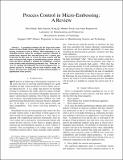| dc.contributor.author | Hardt, David E. | |
| dc.contributor.author | Ganesan, Bala | |
| dc.contributor.author | Qi, Wang | |
| dc.contributor.author | Dirckx, Matthew | |
| dc.contributor.author | Rzepniewski, Adam K. | |
| dc.date.accessioned | 2003-12-15T12:00:00Z | en_US |
| dc.date.available | 2003-12-15T12:00:00Z | en_US |
| dc.date.issued | 2004-01 | |
| dc.identifier.uri | http://hdl.handle.net/1721.1/3917 | |
| dc.description.abstract | Abstract— A promising technique for the large-scale manufacture of micro-fluidic devices and photonic devices is hot embossing of polymers such as PMMA. Micro-embossing is a deformation
process where the workpiece material is heated to
permit easier material flow and then forced over a planar patterned tool. In this work we review the basic process and the state of research with respect to manufacturing process control, where the latter is defined as methods for minimizing variation in the product while maximizing production rate. From this review we conclude the following: Several investigators have reported success at creating micron scale features using this process, but none have performed a formal characterization or optimization of the process. | en |
| dc.description.sponsorship | Singapore-MIT Alliance (SMA) | en |
| dc.format.extent | 25876 bytes | |
| dc.format.mimetype | application/pdf | |
| dc.language.iso | en_US | |
| dc.relation.ispartofseries | Innovation in Manufacturing Systems and Technology (IMST); | |
| dc.subject | micro-embossing | en |
| dc.subject | PMMA | en |
| dc.subject | microfluidic and photonic devices | en |
| dc.title | Process Control in Micro-Embossing: A Review | en |
| dc.type | Article | en |
